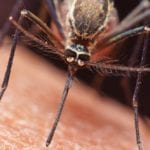 Mysteries
Mysteries  Mysteries
Mysteries  History
History 10 Surprising Stories About the Texas Rangers
 Humans
Humans 10 Philosophers Who Were Driven Mad by Their Own Theories
 Miscellaneous
Miscellaneous 10 Video-Game-Worthy Weapons and Armors from History
 Weird Stuff
Weird Stuff 10 Psychics Who Accurately Predicted Wartime Events
 The Arts
The Arts 10 Pieces of Art Inspired by a Broken Heart
 Health
Health 10 Science Fiction-Sounding New Medical Treatments
 History
History 10 Surprising Facts About the Father of Submarine Warfare
 Space
Space Ten Astonishing New Insights into Alien Worlds
 Weird Stuff
Weird Stuff 10 Bizarre Summer Solstice Rituals Still Practiced Today
 Mysteries
Mysteries Top 10 Haunting Facts About the Ghost Ship MV Alta
 History
History 10 Surprising Stories About the Texas Rangers
 Humans
Humans 10 Philosophers Who Were Driven Mad by Their Own Theories
Who's Behind Listverse?

Jamie Frater
Head Editor
Jamie founded Listverse due to an insatiable desire to share fascinating, obscure, and bizarre facts. He has been a guest speaker on numerous national radio and television stations and is a five time published author.
More About Us Miscellaneous
Miscellaneous 10 Video-Game-Worthy Weapons and Armors from History
 Weird Stuff
Weird Stuff 10 Psychics Who Accurately Predicted Wartime Events
 The Arts
The Arts 10 Pieces of Art Inspired by a Broken Heart
 Health
Health 10 Science Fiction-Sounding New Medical Treatments
 History
History 10 Surprising Facts About the Father of Submarine Warfare
 Space
Space Ten Astonishing New Insights into Alien Worlds
 Weird Stuff
Weird Stuff 10 Bizarre Summer Solstice Rituals Still Practiced Today
Top Ten Macabrely Coolest Bugs in the World
Eighty percent of the world’s animal species are insects, which is to say there are likely more than one million species of bugs, and some experts estimate as many as 10 million. They are under the ground, on the ground, and above the ground. In the bush, in the city, in the desert, in and on the trees, and on and under rocks. In our homes, our businesses, all the places we visit. On our skin, in our hair. In our nightmares. They run, crawl, creep, climb, jump, swim, and fly. If they ever decided to take us on, we would lose, and the earth would be ruled by bugs. Thankfully, they seem content with having invaded and conquered every environment on earth, excluding extreme high-altitude environments, arctic regions, and active volcanoes.
We are unlikely to have face-to-face encounters with many of the insects on this list, and even if we did, they do not represent any real threat to us. They can be viewed and appreciated, or not, from the safety of our living rooms. Although there is an impossible number of candidates for the title of coolest bug on earth, here are ten worthy contenders that, between them, offer some disturbing behaviors, outrageous appearances, wicked party tricks, and a few surprises.
Related: 10 Worldwide Insect Delicacies
10 Dog Flea
These wingless parasites have nothing to their credit apart from their insatiable appetite for blood and their phenomenal jumping ability. Although people often say they have been bitten by a flea, fleas don’t bite. Instead, they saw through the skin using their jagged-edged mandibles, then dribble their saliva, which contains an anti-coagulant, on the wound to keep the blood flowing. The saliva is also what causes the skin irritation from the flea’s feeding session.
Cat fleas are more common than dog, human, or rat fleas, even though feline hosts are fewer in number. However, dog fleas are the most impressive leapers. How far can they jump? Try 200 times their own body length from a standing start. How long are their bodies? Adults typically grow up to anywhere from 2mm to 8mm (between 1/4″ and 1/3″), and they have disproportionately big heads, perhaps because they are so good at jumping. Although their large hind legs enable the mighty leaps, they actually push off from their toes. Who knew fleas had toes?[1]
9 Madagascan Sunset Moth
To set the record straight at the beginning, moths are not simply nocturnal butterflies; there are distinct differences between the two. The Madagascan Sunset Moth is a day-flying moth and arguably the most beautiful of the lepidopterans (moths and butterflies), making them highly sought after by collectors.
The iridescent parts of its wings do not have any pigment. Although nicely framed in white, the intense and magical red, blue, and green seen in this moth’s wings arise from optical interference. Its wings are covered by ribbon-like scales, which diffuse and interfere with light beams. As a final nod to its coolness, this moth has six tails, and like all moths and butterflies, has taste sensors in its feet. That’s not the only way they taste. Still, it is an unusual one unless you consider the convenience of being able to sample flowers simply by landing on them as you flutter around on your pollination mission. In which case, you must admit that it is very cool.[2]
8 Black Bulldog Ant
Australia lays claim to a large number of unique and dangerous animals. The Black Bulldog Ant, which is in the Guinness Book of World Records as the deadliest ant in the world, bites and stings simultaneously. It has been known to cause human deaths, although to be fair, the cause of death was anaphylactic shock. In the three recorded fatalities in Australia, death occurred within fifteen minutes of the onset of the attack.
The Bulldog Ant bites rapidly and repeatedly and is not afraid of people or anything else. These large ants are essentially wasps without wings, so they behave differently from other ant species. Bulldog ants, also known as bull ants, are aggressive, don’t lay scent trails or travel in lines, and live in comparatively small colonies. Incidentally, bulldog ants used to be found worldwide but are now extant only in Australia, presumably because Australians treasure such deadliness in their creatures.[3]
7 Hercules Beetle
Pound for pound, as the saying goes, the Hercules Beetle is not only one of the strongest insects on earth, but it is also one of the strongest creatures on earth. How often have you heard someone strong being compared to an ox? Oxen have nothing on this beetle. Dynastes hercules can lift and carry 850 times its own body weight, equivalent to a human carrying seven elephants.
Males of this large beetle species also have a very distinctive appearance courtesy of massive horns on their heads that look like a set of pliers and are used to fight other males to impress lady Hercules beetles. The battle ends when one of the combatants ends up on his back, unable to flip himself over. Laying to rest a persistent rumor—the truth is the females hook up with the survivor of these fights irrespective of the size of his horns.[4]
6 Common Green Darner
With independent wing control giving them the ability to fly forward, backward, and sideways and hover and turn ninety degrees in a couple of wingbeats, dragonflies make the most advanced modern aircraft look primitive. They are also very fast. The world speed title goes to a North American dragonfly, the Common Green Darner, which given its name, is unsurprisingly ubiquitous throughout North America.
This insect rocks some cool contrasting blues and greens on its body, as well as a black spot inside a yellow and blue ring on its forehead, which is called a “bulls-eye” mark. In colder weather, they change the color of their body to darker hues in order to absorb more sunlight. This species also is one of the only darner species to oviposit in tandem. With a 76 mm (3 inches) body and an 80 mm wingspan, this dragonfly has been clocked at 85 kilometers an hour (52 mph). However, its ability to mend socks has not been tested yet.[5]
5 Brazilian Treehopper
The Brazilian Treehopper has a weird crown of balls on its head and is apparently lazy. The purpose of this regal anatomical feature is something of a mystery to scientists who have at least ruled out any sexual function, given that both males and females of the species have the balls. Their best guess is that it is a defensive weapon designed to discourage predators. If not functioning as a decoy head like some other creatures have, then perhaps it’s there because it is similar in appearance to the results from having a parasitic fungus invade your body.
Although such headwear is unusual in the general insect population, it is very fashionable among the Treehoppers. The crown of hairy balls is, in fact, a “pronotum,” an insect body segment located just behind the head. As for their alleged laziness, individual specimens have been observed to sit and feed in one place for twenty-four hours, which I think qualifies them as gluttons as well.[6]
4 Junk Bug
The junk bug, also known as an aphid lion, is a common voracious predator around the world. The bug is actually the larval stage of the green lacewing, a delicate and lovely flying insect with vibrant and limey green bodies, large eyes, and big, diaphanous wings sporting an intricate filigree of veins that call to mind fairies more than bugs.
But the larval stage, the junk bug stage, is decidedly uglier. Scientists say junk bugs heap their kills on their back as part of an intricate camouflage designed to fool birds and predatory ants alike. Sometimes, the bugs add other bits of debris they find, such as bits of lichen or leaves. Teasing apart the pieces, the insect carcasses are unmistakable. Most are a ghostly white. Heads and legs are easy to discern.
Junk bugs feed by stabbing soft-bodied prey with a pair of sharp, horn-like mouthparts that are hollow. Once stabbed into a victim, the junk bug simply slurps out the soft innards of its prey. Mmm, milkshake, anyone? Then the empty and lifeless husk is added to the gruesome pile, and the junk bug scurries on, looking for his next victim.[7]
3 Ladybug
Lady beetles, or ladybugs, may look pretty, and they are certainly relatively harmless, but they are disease-infested cannibals that may eat up to 5,000 insects during their lifetime, including their siblings. Harlequin ladybugs, also call Harlequin ladybirds, are the chief offenders, with many other species only resorting to eating their own family members when food supplies are low.
A Rice University article adds the descriptors “invasive” and “sex-crazed,” with the author noting that these bugs also give off an unpleasant smell when you bother them. Oh, and they can bite. Now that your glowing opinion of ladybirds has been shattered, you might be wondering why they are on this list of cool bugs. What’s so cool about them? They make the cut because there is probably no better example in the animal kingdom of a wolf in sheep’s clothing than a ladybug.[8]
2 Dracula Ant
The agile and possibly psychotic Dracula ant, motoring at 90 meters per second, is the fastest animal in the world. Not only do they move super quickly over the ground, but according to National Geographic, their bite is the fastest animal movement on record. The biting action is similar to the way we snap our fingers, with stored energy producing sound in the case of our fingers and a devastatingly fast bite in the case of these ants.
It is both the speed and the power of the bite which stuns the Dracula ant’s prey. Queens also suck the blood of their own young because Dracula ants, apparently not keen on being in Her Majesty’s Service, don’t share regurgitated food in the colony.[9]
1 Twisted Wing Parasite
There are many examples of parasitic behavior in the animal and plant kingdoms. It doesn’t bother us at all when we hear examples of plants living off other plants because plants don’t have feelings, but when the talk turns to animals, it starts to become uncomfortable. When humans describe other humans as parasites, it is a high-level insult. We don’t see “bloodsucking” behavior as good even though we accept it among animal species because it is natural. We may not necessarily understand it, but everything in nature serves a purpose. All that is by way of an introduction to the “sickly cool”’ Twisted Wing Parasite.
This extremely unpleasant, almost vomit-inducing insect is the bee’s knees of disgustingly cool bugs. Finding its hosts among grasshoppers, leafhoppers, bees, and wasps, the larval form of this fly waits around for a host then climbs on board, burrowing into the insect. Once settled, it morphs into a second-stage larva, either male or female. If male, he will burst out of the host to go and find a mate. If female, she will find her own host, burrowing in and only poking out her genitals (which is about all she has since she possesses no eyes, antennae, legs, or mouthparts). Once impregnated, she produces her eggs, which grow and consume their mother before hatching, continuing the cycle.
Ladybugs have been previously described as sex-crazed, but twisted wing parasites spend most of their three-hour lifespans looking for a mate. For them, sex is the meaning of life. Talk about twisted.[10]








